
 by Steven D. Johnson
by Steven D. Johnson
Racine, Wisconsin
(Page 2 of 4)
Previous Page
1
2
3
4
Next Page
Hot Melt Glue - Not Just For Floral Arrangements And Beads
Click on any picture to see a larger version.
Jerry Seinfeld famously found fault with every woman he dated… she has man hands, she eats her peas one at a time… for almost any reason, or no reason at all, Jerry broke up with every one. The story lines were comedy but the inability to ever be completely satisfied is tragedy… or a personality flaw.
Falling in love with my
new aluminum bar clamps
did not stop me from finding faults. The clamps do not include, or offer as accessories, clamp pads. The clamp faces could be a bit higher. I suppose, as Hawkeye said in an episode of M*A*S*H, I am looking for a "custom fit" in an "off the rack" world.
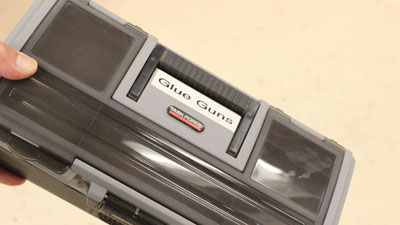
|
|
Figure 5 - My glue guns and supply box
|
Since no clamp is perfect and none is even close to "universal" in its applicability (which, I suppose, is why we all have so many and want so many more), it is my custom to fashion clamp pads from small scraps of plywood that are specific to each glue-up. Sometimes a small square is all that is needed, just to prevent clamp marks on the wood. Sometimes a taller pad can compensate for a clamp face that is too short. Sometimes a wider clamp pad is needed to spread the clamping force on a wide work piece. Making and attaching these "custom" clamp pads is second nature and a big part of every glue-up I prepare to do.
Often I use blue painter's tape to attach the pads to the work piece, often I use hot melt glue to attach the clamp pad directly to the faces of the clamps. Do you use hot melt glue in your shop? I use the stuff so much that I keep my hot melt glue gun and supplies in a box right inside my glue-up supply cabinet. Some woodworkers think of hot melt glue as something only a crafter uses to attach beads to fabric, but it has dozens of uses in the shop.
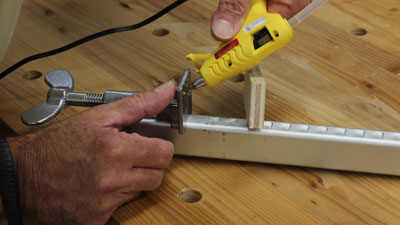
|
|
Figure 6 - Apply a couple of spots of hot melt glue and...
|
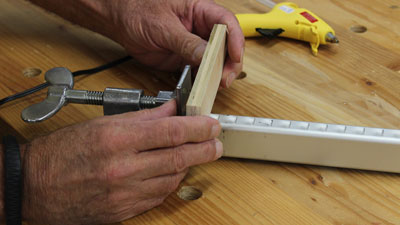
|
|
Figure 7 - ...attach the clamp pad
|
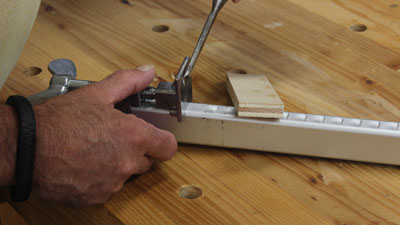
|
Figure 8 - When finished with the glue-up the pad snaps off.
Any remaining glue pops off easily.
|
The variety of available adhesives for glue guns seems endless… low tack, high tack, fabric to fabric, plastic to plastic, wood to wood, metal to anything, clear, colored, and even glues that show up under a black light. Choose an assortment wisely and you can make a lot of temporary attachment tasks in the shop much easier.
Sometimes when trying to design a piece and get a sense of the scale and how different components work together, a full size mock-up is the only way to go. With cardboard, Styrofoam, and a few bits of wood I can mock up almost any piece of furniture in just a few minute's time using hot melt glue.
For a photo I needed a solid black background. With no less invasive way to hang the fabric, I put a couple of drops of hot melt glue in the corners and tacked the cloth to my ceiling. When the photos were done, the glue pried off cleanly. The corner of my precious wipe off marker board came loose, and not wanting to take the time for a "conventional repair" I plugged in, warmed up, and fixed it with a couple of drops of hot melt. Just apply the hot glue, hold the pieces in place for a few seconds till the glue cools, and the job is finished.
Another use is when cutting multiple identical pieces at the band saw. I used to spend a lot of time with double-stick tape. Now I use a couple of drops of hot melt glue to hold the pieces together securely for sawing and later the pieces pop apart easily and cleanly.
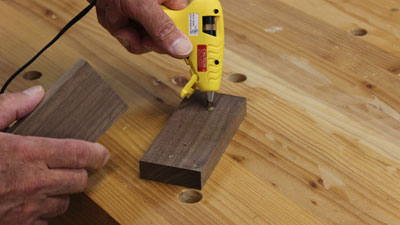
|
Figure 9 - When cutting multiple pieces, a couple of spots
of hot melt glue holds as well as self-stick tape
without all the hassle
|
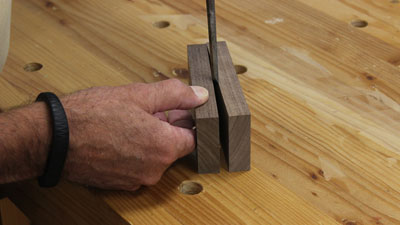
|
|
Figure 10 - Parts separate easily.
|
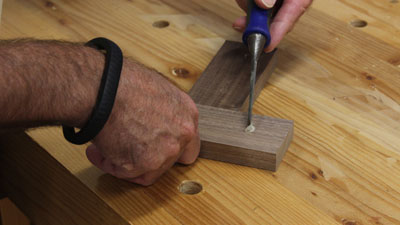
|
Figure 11 - Hot melt glue dots peel off easily and generally
leave little or no residue.
|
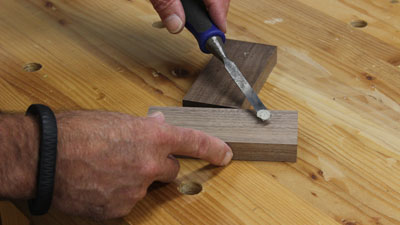
|
|
Figure 12 - The little flattened dot of glue.
|
The glue gun I use cost about $10 about ten years ago. It might cost $11 by now.
I have a more expensive glue gun. I think that one cost $15. It is a little bigger, takes bigger glue sticks, and fits my hand nicely. Ostensibly it will heat up more quickly, perhaps control the flow of glue better, and if I'm lucky, maybe it won't drip glue when it shouldn't like my cheaper model. That's a small price to pay though and I have no intention of switching to the bigger gun until I use up all the glue sticks that fit my "cheap" gun.
If someone in your family has one of these handy gadgets, appropriate it for shop use or pick one up for yourself. You will likely find all kinds of uses for it.
(Page 2 of 4)
Previous Page
1
2
3
4
Next Page
Return to
Wood News
front page

